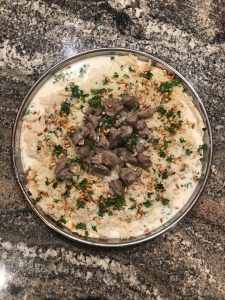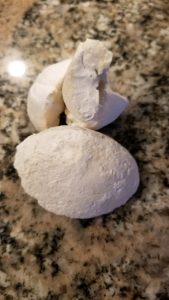
My name is Amy and I am a third-year Loyola student with a double major in Political Science and Global and International Studies, and a minor in Arabic Language and Culture. My dad is originally from Madaba, Jordan, and my mom is from Kazmierza Wielka, Poland. I’m happy to share a blog on a special Jordanian dish and a special family time!
Mansaf is an important cultural dish that has a rich significance in the country of Jordan as well as throughout Palestine, Iraq, Syria, Saudi Arabia, and Lebanon. Although it is usually saved for special occasions, it is a dish that I grew up eating, cooked by my father, not only for special occasions, but also in our day to day lives. He would make it for my family when we asked for it, because he knew that it was one of my favorite foods to eat, especially when it was cold outside.

The creation of mansaf dates back to the Jordanian Bedouins, and the dish is not only considered the national dish of Jordan, but it also signifies hospitality and generosity. It consists of a base layer of shrak bread, a traditional thin Bedouin bread cooked on the bottom of a hot cast iron skillet, a generous pile of rice tinted with turmeric, cooked spiced pieces of lamb meat, and yogurt stew/jameed sauce poured over the top (Sharif).


My dad also likes to add some golden fried pine nuts and almonds. I was surprised to learn that rice is not a native food to Jordan, despite its being featured in a majority of the country’s dishes. Rice was actually imported to Jordan in the 20th century, and mansaf was traditionally cooked with ground wheat, or jarishi. The host of the meal must always ensure that each guest has a plentiful supply of meat and jameed sauce on their portion of rice, which emphasizes the hospitable roots of the dish because the host is expected to give the highest respect and warm hospitality to their guest in order to show them appreciation.
I was also surprised to learn that there is a method to eating mansaf. I am not used to eating it with my hands, but I was interested to find out that it is meant to be eaten with the hands off of a big platter. It is much more complicated, however, than just diving in with one’s hands.

Mansaf must be eaten with the right hand, and with the left hand placed firmly behind the back in order to limit any possible confusion. My dad and I tried eating it this way, but I quickly grabbed a bowl and spoon to eat from, because the mansaf was too hot! Growing up, I never learned the history of mansaf or why it was so culturally relevant and beloved by my whole family, but learning the origins and history of the dish, as well as the different regional adaptations of it, has changed the way that I think about the dish and allowed me to make and eat it in a more intentional manner.
